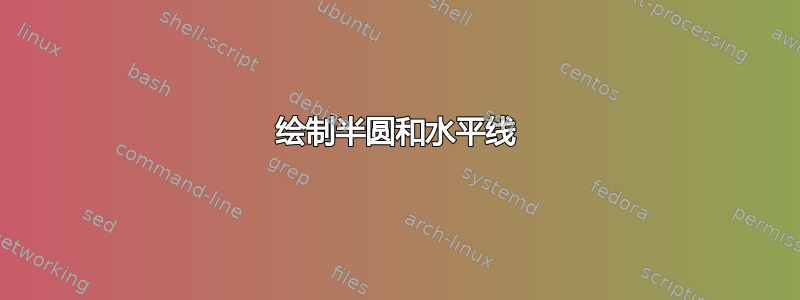
我想画出平行线和它们之间的半圆,像附图这样 ......你能帮帮我吗?
......你能帮帮我吗?
答案1
另一个(可能更好的)完整解决方案是使用intersections和calc库借助构造,\foreach如下所示:
\documentclass{standalone}
\usepackage{tikz}
\usetikzlibrary{calc,arrows,positioning,intersections}
\begin{document}
\def\dis{1cm}
\begin{tikzpicture}[line width=0.7pt,>=latex',node distance=\dis]
\node (o) at (0*\dis,8*\dis) {$\ast$};
\path [draw,name path=bigarc1, bend right=10,->,shorten >=10pt](o.center)to([xshift=2.5*\dis,yshift=-7*\dis]o);
\path [draw,name path=bigarc2, bend left=10,->,shorten >=10pt](o.center)to([xshift=-2.5*\dis,yshift=-7*\dis]o);
\foreach \y/\c in {7/1,6/2,5/3,4/4,3/5,2/6}{
\path [draw,name path=Line-\c] (-3*\dis,\y*\dis)--(3*\dis,\y*\dis) node[right=0.2*\dis]{$V_{\c}$};
\path [name intersections={of = bigarc1 and Line-\c}];
\coordinate (p) at (intersection-1);
\path [name intersections={of = bigarc2 and Line-\c}];
\coordinate (q) at (intersection-1);
\draw [bend left,shorten >=-5pt,shorten <=-5pt](p)to(q);
}
\end{tikzpicture}
\end{document}
这样的代码的输出是符合预期的:

我根据Sigur的想法完成了另一个解决方案作为替代方案。
完整代码(遵循Sigur的想法)如下:
\documentclass{standalone}
\usepackage{tikz}
\usetikzlibrary{calc,intersections,arrows,positioning}
\begin{document}
\begin{tikzpicture}[>=latex']
\node (p-0) at (0,0) {$\ast$};
\node (q-0) at (0,0) {};
\foreach \raft/\rbef in {1/0,2/1,3/2,4/3,5/4,6/5}{
\path [draw, name path global/.expanded =L-\raft](-6,-\raft)--(6,-\raft) node [right] {$V_{\raft}$};
\path [draw, name path global/.expanded =A-\raft,thick] (-120:1.1*\raft) arc (-120:-60:1.1*\raft);
\path [name intersections/.expanded ={of ={L-\raft} and {A-\raft}}];
\coordinate (p-\raft) at (intersection-1);
\coordinate (q-\raft) at (intersection-2);
}
\draw [->,shorten >=-10pt](p-0.center)--(p-1)--(p-2)--(p-3)--(p-4)--(p-5)--(p-6);
\draw [->,shorten >=-10pt](q-0.center)--(q-1)--(q-2)--(q-3)--(q-4)--(q-5)--(q-6);
\end{tikzpicture}
\end{document}
该代码的输出如下图所示:

但与题目要求的数字稍有不同。
答案2
部分解决方案(使用tikz)
\documentclass{report}
\usepackage{amsthm,amsmath,amssymb}
\usepackage{tikz}
\begin{document}
\begin{tikzpicture}
\node at (0,0) {$\ast$};
\foreach \r in {1,2,...,6}{
\draw (-6,-\r)--(6,-\r)node[right]{$v_{\r}$};
%\draw (-135:\r) circle (1pt);
\draw[thick] (-135:1.2*\r) arc (-135:-45:1.2*\r);
}
\end{tikzpicture}
\end{document}
圆弧的语法需要初始点P来确定射线OP,然后使用第二个参数,即初始角度、最终角度和半径。

另一张解释角度的图像(在极坐标中(angle:radius)):



